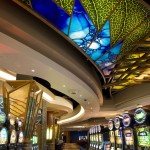
Lee Allen, Indian Country Today Media Network
This may not be the true dawning of a new age, but Indian casinos are poised on the precipice of change —one foot anchored in time-honored methods of success, the other embracing modernity.
The move toward innovation includes a transition to progressive design with contemporary and green aesthetics, as well as finding creative ways to reach a younger audience keen on social media.
Casino owners need to straddle the chasm of traditional ways and new, understanding the social aspects of both segments of the market to keep the current crowd happy while attracting the next generation of gamers.
“We can’t see the future clearly yet, but we know change is inevitable,” said architect Nick Schoenfeldt, vice president at Thalden Boyd Emery Architects. “We need to continue serving today’s gaming public in the existing first generation of gaming facilities built in the late 1980s even as we design and build new attractions for tomorrow.”
Comments by architects, designers, contractors, owners and operators resonated at the 6th annual Native Nation Events Tribal Casino & Hotel Development Conference, February 21-22, at the Pascua Yaqui-owned Casino del Sol Resort Hotel in Tucson, Arizona. The conversational buzz was heightened by a rare occurrence—a snow storm that turned desert cacti into a winter wonderland.
Panel moderator Ronn Lansky, the business development director for the Detroit-based PENTA Building Group, noted that over the past several decades, the design of casino floors hadn’t changed strikingly. Then he cited the current trend of “building landmark buildings that will affect generations to come.”
Other attendees echoed a major voice of the industry, Casino Design magazine, which emphasized in an April 2010 article, The Brave New World of Design and Construction: An Industry Round Table, that casinos need to look “clean, edgy, contemporary”—the predominant visual appeal. The magazine quoted another design and construction expert who said, “We must dazzle the eye and soothe the senses.”
Panelists at the February conference specifically cited the advent of smaller slot banks and wider aisles at newer casinos intended to provide a more intimate sense of gaming—the same aura as that of a lounge.
“Casino floors are evolving to be more social and community-focused and you need to understand your market and design the floor with customer segments in mind,” said Janet Beronio, general manager of Harrah’s Rincon Casino & Resort.
“We used to have long, long banks of machines—essentially a slot warehouse, but change in machine spacing is now evident,” Beronio said. “We once dedicated 20-to-25-square feet to a bank of eight slots; now we’re seeing 30-square feet in a zone format anchored by carousels and dedicated pathways. The casino floor still has compelling content, but the feeling is now more community and social.”
The cost to create that feeling is not cheap, according to C.J. Graham, general manager of 2,500 employees at the Lincoln, California-based Thunder Valley Casino, which recently underwent a $700 million facelift (while continuing operations with minimal incremental disruption). “At the end of the day, you still need to show a profit,” he said.
Graham has a base demographic of age 50-plus customers, but also a growing following in the 21-to-30-year-old group. “We still have folks who love the old Red, White and Blue reels, but there’s a tech-savvy element coming along that we can ping on their cell phones and make the younger visitor special offers as they come through the door. The generational change won’t happen overnight, it will take decades, but it’s already underway.
“Even with the modern side of technology emerging, we won’t lose the energy that allows casino floors to be successful,” adds Beronio. “Brick and mortar sites still have the energy of community, people cheering for each other, and that will still appeal to multi-tasking tech-savvy youth.”
Other panelists like Osage Nation Chief John Red Eagle know that casino floor designs and technologies are forever adapting and need to stay relevant. Tribes need to capitalize on up-to-date technology like energy-saving geo-thermal capabilities. “We want the best possible development we can produce with the money we have,” he said.
Fellow panelist Jamie Fullmer (Yavapai Apache), chairman and CEO of Blue Stone Strategy Group, which advises tribes in making strategic decisions for financial growth and sustainability, summed up the challenge many tribes will face when desires meet feasibility and financing: “Here’s our dream balanced with a pocketbook reality.”
Those realities range from incorporating complex and still developing technology to making changes like widening aisles and adding more restaurants for a diverse clientele.
“Regardless of the renovation, addition, or new build,” said Graham, “you can’t diminish the guest experience…you can’t just send guests home…so you need to minimize the disruption and adjust on the fly while building a better casino for tomorrow.”
Read more at http://indiancountrytodaymedianetwork.com/2013/03/05/trends-indian-gaming-whats-ahead-147999
